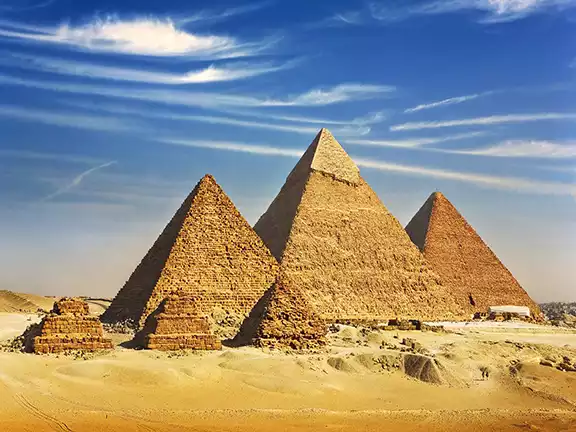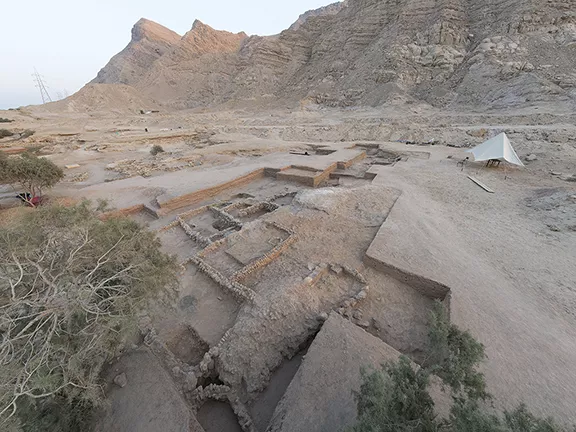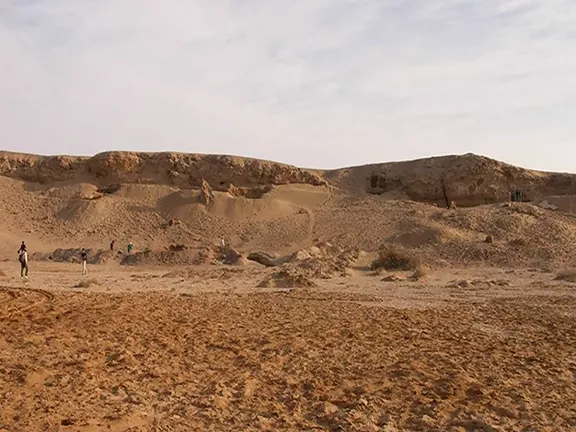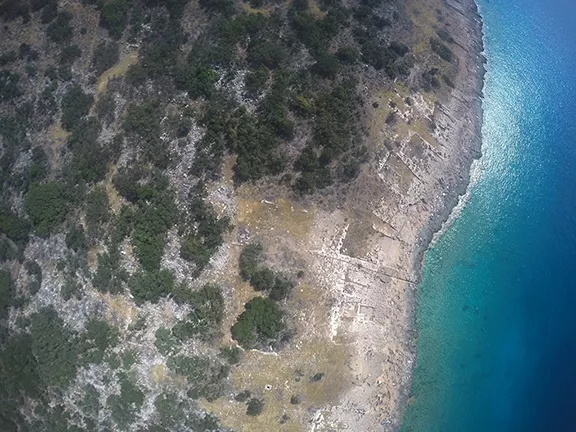Ancient Mediterranean Shipyards and Harbours
The World's Oldest Harbour: Egypt's Wadi al-Jarf Breakwater c 2600 - 2560 BC
Wadi el-Jarf, the world's oldest known artificial harbour, was briefly used during the late Fourth Dynasty (c. 2600 BC) under King Khufu. Its function was to launch expeditions to the Sinai Peninsula's mines. The site's rock-cut galleries and a cache of papyri, known as the Diaries of Merer, provide direct evidence of the logistics for these state-sponsored missions.
By Nick Nutter on 2025-09-1 | Last Updated 2026-01-1 | Ancient Mediterranean Shipyards and Harbours
This article has been visited 2,014 times

Wadi al-Jarf. Photo G. Marouard
Wadi al-Jarf Breakwater: Early Egyptian Maritime Engineering
The Wadi al-Jarf breakwater, a relatively recent archaeological discovery on Egypt's Red Sea coast, has fundamentally reshaped our understanding of ancient Egyptian engineering and maritime capabilities. While people globally celebrate the Egyptian civilization for its colossal pyramids and monumental temples, the finding of the world’s oldest known artificial harbour structure reveals an equally impressive command of logistical planning and large-scale maritime construction. The Wadi al-Jarf breakwater represents a landmark achievement in early civil engineering, providing evidence of a sophisticated state-sponsored maritime infrastructure that supported the ambitious expeditions of the Old Kingdom.
Do you enjoy my articles? For your reading pleasure, this website does not carry third party ads. You could help me write more articles by buying me a cup of coffee.
When was the Wadi al-Jarf breakwater discovered?
A French-Egyptian archaeological team led by Pierre Tallet began excavating the Wadi al-Jarf site in 2011. While the site itself, including the cave galleries, had been noted by others as far back as the 19th century, it was Tallet's team that systematically excavated the area and identified the breakwater and other structures as the components of the world's oldest known artificial harbour.
Where is the Wadi al-Jarf breakwater?
The Wadi al-Jarf breakwater is situated on the Red Sea coast of Egypt, about 119 km south of Suez, at the mouth of the Wadi Araba.
When was the Wadi al-Jarf breakwater built?
Archaeologists identified the site of Wadi al-Jarf as a harbour complex dating back to the reign of Pharaoh Khufu, who reigned between 2589 and 2566 BC. Pharaoh Khufu (also known as Cheops) was the pharaoh responsible for the Great Pyramid of Giza, though some evidence suggests earlier use under Khufu’s predecessor, Snefru, the founder of the 4th Dynasty who reigned between 2613 and 2589 BC.
More than just a breakwater


Gallery at Wadi al-Jarf
The excavations revealed a range of features, including a series of storage galleries carved into the limestone hills, boat fragments, and, most crucially, a submerged jetty or breakwater.
How was the Wadi al-Jarf breakwater built?
Workers constructed the L-shaped structure from large limestone blocks and pebbles. The breakwater was approximately 325 metres long and extended into the water to create a protected basin. The sheer scale of this project demonstrates a remarkable level of organizational and technical skill. It was not merely a natural inlet, but a purpose-built structure designed to provide safe anchorage for a fleet of ships, proof of the Egyptians’ mastery of marine engineering over four millennia ago.
Today, part of it is visible on a rocky head. It extends eastward for about 160 metres, then irregularly southward for about 130 metres.
What was the purpose of the Wadi al-Jarf breakwater?
The structure served as a barrier against northern waves and currents, creating a large, sheltered water area (estimated at least 5.67 hectares) where ships could safely dock and depart.
The artifacts found at the site illuminate the purpose of this meticulously engineered harbour, particularly a collection of papyri, which are the oldest ever discovered. Known as the Diary of Merer, these texts document the daily life and activities of an inspector in charge of a work team. The papyri reveal that the harbour served as a vital departure point for expeditions to the Sinai Peninsula, where Egyptians mined for valuable copper and turquoise.
Merer's logbook also details the transportation of massive limestone blocks, which Tallet posits were intended for the cladding of the Great Pyramid at Giza. This connection reveals the central role of the Wadi al-Jarf harbour within the state’s logistical network, linking a distant port on the Red Sea to the monumental construction projects in the Nile Valley.
It is also speculated that it may have been a departure point for voyages to "the mysterious Land of Punt."
Associated Discoveries in Wadi al-Jarf


4th Dynasty anchor from Wadi al-Jarf
Anchors: Over 100 stone anchors dating back to the 4th Dynasty have been found at the site, some still bearing hieroglyphs that likely indicate the names of the boats. This was the first time Old Kingdom anchors were found in their original context.
Storage Galleries: Carved into the mountains about 6 kilometres west of the seashore, archaeologists discovered a system of 25 to 30 storage galleries, 16 to 34 metres long, 3 metres wide, and 2.5 metres tall. They used these to store boat parts, shipping materials, and supplies for voyages.
Papyri: Hundreds of papyrus fragments were found, including the "Diary of Merer." Merer was an official involved in the transportation of stone to the Giza Plateaux during the reign of Khufu. These are the oldest papyri ever found in Egypt and provide invaluable insights into the daily lives and logistical organization of the Old Kingdom.
Camps and Dwellings: Remains of camps and dwelling places for port workers were also excavated.
The significance of the Wadi al-Jarf breakwater
The Wadi al-Jarf site is incredibly important for understanding the advanced organizational capabilities and maritime activities of ancient Egypt during the Old Kingdom. It demonstrates the sophisticated logistical operations involved in royal projects like the construction of the pyramids and resource acquisition from distant lands. The site at Wadi al-Jarf is the first known instance of those skills being put to use in a marine environment.
When was Wadi al-Jarf abandoned?
It is likely that Egyptians abandoned the harbour installation at Wadi al-Jarf after the reign of Khufu, with subsequent expeditions using other ports like Ain Soukhna.
References
Tallet, P. (2014) “The harbor of khufu :On the red sea coast at Wadi Al-Jarf, Egypt" and "The Harbor Facilities of King Khufu on the Red Sea Shore: The Wadi al-Jarf/Tell Ras Budran System"
History of Information: "Pierre Tallet Discovers the Earliest Known Egyptian Papyri" and "The World's Oldest Harbor"
Smithsonian Magazine: "The World's Oldest Papyrus and What It Can Tell Us About the Great Pyramids"
Ancient Coastal Settlements, Ports and Harbours: "The Harbor Facilities of King Khufu on the Red Sea Shore: The Wadi al-Jarf/Tell Ras Budran System"
AMeRS: "THE HARBOR OF KHUFU"
Wikipedia: "Wadi al-Jarf"
The History Blog: "King Khufu's port, papyri found on Red Sea"
Other People's Tales: “Wadi el Jarf: The Harbour of King Khufu on the Red Sea Shore and its Papyrological Archive”
Do you enjoy my articles? For your reading pleasure, this website does not carry third party ads. You could help me write more articles by buying me a cup of coffee.
 2: Egypt's Ro-She Khufu 2580 - 2500 BC
2: Egypt's Ro-She Khufu 2580 - 2500 BC 3: Egypt's Ayn Soukhna c 2500 - 1850 BC
3: Egypt's Ayn Soukhna c 2500 - 1850 BC 4: Egypt's Mersa/Wadi Gawasis c 2000 - 1500 BC
4: Egypt's Mersa/Wadi Gawasis c 2000 - 1500 BC 5: Dana Island, Turkey c 800 BC - 700 AD
5: Dana Island, Turkey c 800 BC - 700 AD